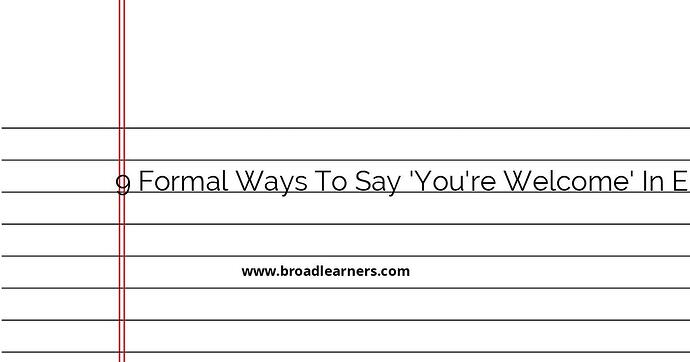When someone expresses gratitude and says 'thank you', it is important to respond with a polite and formal acknowledgement. While 'you're welcome' is a common phrase, there are several alternatives that can be used in different situations. Here are nine formal ways to say 'you're welcome' in English:
- I'm happy to help
- It's my pleasure
- You're quite welcome
- I'm glad I could assist
- Not a problem at all
- It was my pleasure to help
- You're very welcome
- Anytime
- Don't mention it
Different phrases may be more suitable depending on the context and the relationship between the speaker and the person expressing gratitude. Let's explore each alternative in more detail:
1. I'm happy to help
This response communicates that you are glad to have been of assistance and that it brings you satisfaction to help others. It shows a positive and eager attitude towards providing support.
Example:
Person A: Thank you for helping me with the project.
Person B: I'm happy to help. It's important for me to contribute to the team's success.
2. It's my pleasure
This phrase conveys that assisting the person was a source of pleasure and enjoyment for you. It emphasizes that you take delight in helping others and find it personally rewarding.
Example:
Person A: Thank you for arranging this meeting on short notice.
Person B: It's my pleasure. I understand the importance of timely coordination and I'm always happy to help.
3. You're quite welcome
This response expresses that the person expressing gratitude is genuinely welcome and that you are happy to have been of assistance. It conveys a sense of warmth and appreciation.
Example:
Person A: Thank you for reviewing my presentation and providing valuable feedback.
Person B: You're quite welcome. Your work is always top-notch, and I'm happy to assist in any way I can.
4. I'm glad I could assist
This phrase shows that you are pleased to have been able to help and that you recognize the value of your support. It conveys a sense of satisfaction in contributing to the person's needs.
Example:
Person A: Thank you for troubleshooting the issue with my computer.
Person B: I'm glad I could assist. Technology can be frustrating, and I'm always here to help solve any problems you encounter.
5. Not a problem at all
This response conveys that providing assistance was effortless and did not inconvenience you in any way. It reassures the person expressing gratitude that their request was not a burden.
Example:
Person A: Thank you for staying late to finish the report.
Person B: Not a problem at all. I know how important it was to meet the deadline, and I'm always committed to delivering high-quality work.
6. It was my pleasure to help
This phrase emphasizes that providing assistance was a personal pleasure for you and that you genuinely enjoy helping others. It shows that you derive satisfaction from meeting their needs.
Example:
Person A: Thank you for proofreading my article before submission.
Person B: It was my pleasure to help. I find joy in supporting your writing journey and ensuring that your work is polished to perfection.
7. You're very welcome
This response conveys that the person expressing gratitude is highly welcome and that you appreciate their acknowledgment. It provides a sense of genuine hospitality and openness.
Example:
Person A: Thank you for inviting me to the meeting.
Person B: You're very welcome. Your expertise and input are highly valued, and I'm glad you could join us.
8. Anytime
This phrase communicates that you are always available and willing to help whenever needed. It conveys a sense of reliability and continuous support.
Example:
Person A: Thank you for providing guidance throughout the project.
Person B: Anytime. I'm here to support you and the team in achieving our goals, so feel free to reach out whenever you need assistance.
9. Don't mention it
This phrase suggests that the assistance provided was insignificant in comparison to the gratitude expressed. It indicates humility and downplays your contribution.
Example:
Person A: Thank you for helping me organize the event.
Person B: Don't mention it. I know how important this event is for our team, and I'm always happy to lend a hand.
By using these alternative phrases, you can respond to expressions of gratitude with poise and professionalism. Consider the context and the relationship when selecting the most appropriate response. Remember, showing appreciation for appreciation enhances positive interactions and builds stronger connections in professional environments.
Did I miss anything? Respond below
